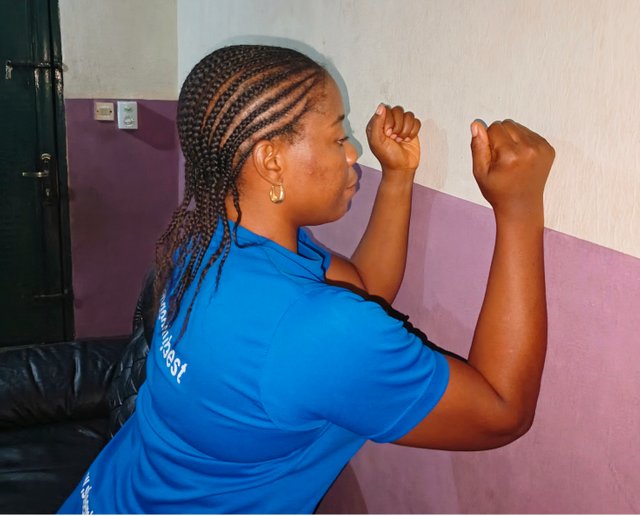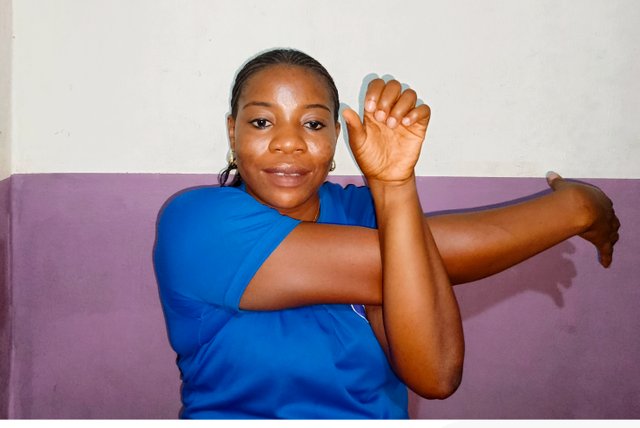Steemit Learning Challenge-S22W4; Rotator Cuff Tendonitis"
Hi friends it's a pleasure to be part of this week's contest. The condition known as rotator cuff tendonitis can deprive us of simple joys in our lives, joys like lifting our child into our arms or reaching what we need on our shelf. Rotator cuff tendonitis is common and it's characterized by pain in the shoulder because the tendon is inflamed. The condition can disrupt our normal routine or stop us from enjoying our hobbies and passions. But don't be too sad because physical therapy intervention can work wonders and make one feel better again. If you're suffering, or you know anyone who suffers from this condition, there are some targeted exercises and manual therapy that can help you to recover quickly. We have to understand and address the underlying causes of tendonitis and then carry out physical therapy to get back on our feet.
Rotator Cuff Tendonitis: it's a condition whereby the muscles and tendons that stabilize our shoulder joints are inflamed or become irritated, and this can make us feel pain, stiffness, and immobility in our shoulder area.
Pain in the shoulder: We may feel pain either in front or by our shoulder side, and the pain may radiate to our arm.
Stiffness: We may find it difficult to move our shoulders especially if we raise our arms to reach something overhead.
Night pain: Many who suffer from this condition may find that the pain worsens at night, especially if they're lying on the affected shoulder.
Limited Range of Motion: The patient may find it hard to carry out his or her daily routine such as putting on dresses or reaching for something on a shelf.
Weakness: The shoulder will become weak especially if the person wants to carry or lift objects.
Various factors contributed to rotator cuff tendonitis, these include:
Repetitive Actions: Overusing our shoulder can lead to this condition; for example, if we repeat activities like throwing, weight lifting, or swimming, they can lead to tendon irritation.
Aging: Isn't it obvious that old age comes with different kinds of bad conditions? And rotator cuff tendonitis is one of such. As we age the tendons can degenerate and become more susceptible to inflammation.
Injury: if we fall and hit our shoulder before, or someone hits us hard or has any awkward movement before, it can cause tendonitis.
Poor Posture: If we don't carry our body properly during activities like exercising, we can put extra stress on our shoulders.*
1. Stage 1 Acute Inflammation: this is the first stage; at this stage, the person will experience sudden pain and swelling because he overused the shoulder or he has an injury. The pain will worse at night when he carries out certain activities.
2. Stage 2 Chronic Inflammation: At this stage the pain will persist if not intervened and it may become chronic. Pain can be more constant and the person may not move the shoulder easily again and will feel discomfort during daily routine.
3. Stage 3 Tendon Degeneration: this is the last and advanced stage, where the tendons may start to deteriorate due to chronic inflammation. This may make the rotator cuff tendons to tear and the shoulder will become so weak.
Rotator cuff tendonitis is a common condition anyone could suffer, and it can affect our normal routine. If we recognize the symptoms early and know what causes them, and then take the necessary actions like resting, physical therapy and consulting health care provider can address the problem at the initial stage.
To diagnose rotator cuff tendonitis I will combine the patient's medical history, physical examination, and specific tests. Below is what I would do:
1. Clinical History: I would ask the patient if she's feeling pain in her shoulder if he raised her arms overhead and the time she usually feels it the worst.
- Medical History: I would ask her if she had an injury in her shoulder before, her exercise habits, or any other activities that may strain her shoulder.*
2. Physical Examination: I will check if her shoulder swells, is red, or is deformed.
- *I will assess how well she can move her hands, and then note any discomfort when she's moving.
3. Imaging Test: I will demand an MRI as this will show me if there's any inflammation or deformities in her shoulder.
4. Arthroscopic: I may resolve on using an arthroscope (a small camera that will allow me to examine the inside of my patient's joint thoroughly and be able to diagnose rotator cuff tendonitis.
5. Special Test:
(a) Yergason Test: this test will allow me to check the patient's shoulder stability. I will perform this test by bending the patient's elbow at 90 degrees and then asking her to rotate her forearm outward. If she experiences pain in her upper arm area it shows that she has rotator cuff tendonitis.
(b) Speed Test: I will perform this test by asking the patient to raise her arm in front with her palm up. If the patient feels pain in her shoulder front, it suggests a positive test.*
(c) Jobe's Test: This test will allow me to evaluate the muscle function at the rotator cuff. I will perform this test by asking the patient to raise her arms to shoulder level in a thumbs-down position and then I will apply a downward pressure. If her shoulder becomes weak or she experiences pain it shows a positive test.*
*(d) Hawkinn-Kennedy test: This test will allow me to assess rotator cuff irritation. I will perform this test by asking the patient to lift her arm to shoulder height, bend at her elbow, and internally rotate. If she experiences pain it suggests a positive test.
(e) Neer Test: I will perform this test by asking the patient to raise her arm straight overhead while she stabilizes her shoulder blade. Any pain will mean rotator cuff problems.
These tests will help me to pinpoint where the shoulder pain is coming from and to differentiate rotator cuff tendonitis from other shoulder issues.
- Scapular Squeeze: I noticed that the muscle around my shoulder blade was strengthened. My posture, too, was improved, and I feel good stretching, and now I know my shoulder position.
- Cross-body shoulder Stretch: this one targets my shoulder and my upper back; I felt relaxed after the exercise and became more flexible.
- Walk Slides: this exercise really engaged my arms. It encouraged mobility in the shoulder, and I felt refreshed.
Well I didn't apply either a heat pack or an ice pack before performing the exercises because I'm not suffering from rotator cuff tendonitis but those diagnosed with his condition should apply either a heat pack for chronic condition or an ice pack for acute condition before carrying out the exercises, this will help in relaxing their muscles and reduce stiffness making the exercises to be more effective and comfortable.
Rotator cuff tendonitis is a common condition anyone could suffer, and it can affect our normal routine. If we recognize the symptoms early and know what causes them, and then take the necessary actions like resting, physical therapy and consulting health care provider can address the problem at the initial stage.



Thank you for understanding the lesson and sharing your assignment; I hope that you will enjoy this week's lesson and try to implement it in your life if you see any such case.
Observations
Task 1 (2.6/3)
You have shared a great knowledge about rotator cuff tendonitis, its symptoms, causes and it's stages. But it would be better add the name of stages given in the lesson post and also you didn't add the SITS muscles of rotator cuff. A bit more depth require to complete the answer. I appreciate your effort.
Task 2 (3/3)
In the second question, you tell us about how you have to assess a patient by doing physical examination, history taking, and investigations. That's good you add special tests and also explanation of both special tests and investigations. Excellent.
Task 3 (3.9/4)
You try the cross body shoulder stretch, scapula squeeze and wall slides. You did the cross body shoulder stretch, scapula Squeeze and wall slides correctly. But in scapula squeeze try to hold the position for 5 to 10 seconds. Relax for 3 to 4 seconds and perform again. Always remember to apply heat pack in chronic condition and ice pack in acute condition before performing exercises to relax the muscles and reduce stiffness. I appreciate your efforts.
Overall you made a great attempt to answer all the questions. I appreciate your efforts. But next time try to avoid the above written suggestions. Keep learning and try to implement your knowledge to the people suffering from rotator cuff tendonitis or any type of shoulder issue. Thank you.
Thank you!
Congratulations, your post was upvoted by @supportive.
Request treatment and home remedies for back pain doc....